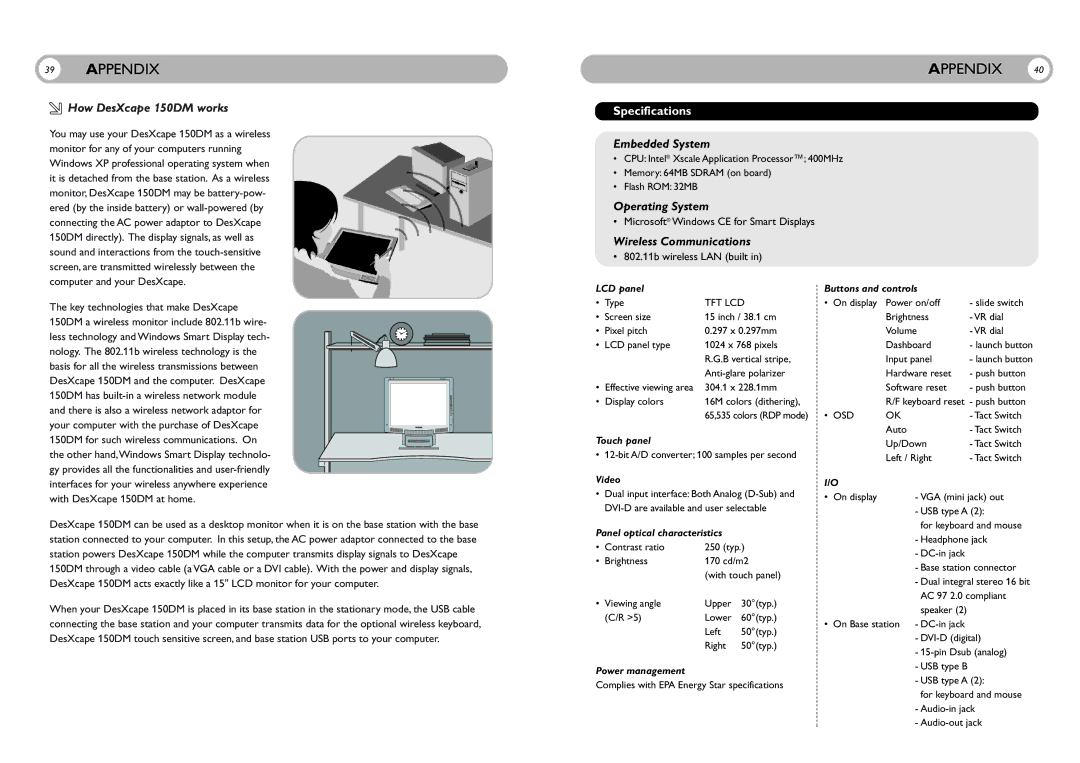
39APPENDIX
 How DesXcape 150DM works
How DesXcape 150DM works
You may use your DesXcape 150DM as a wireless monitor for any of your computers running Windows XP professional operating system when it is detached from the base station. As a wireless monitor, DesXcape 150DM may be
APPENDIX 40
Specifications
Embedded System
•CPU: Intel® Xscale Application Processor™; 400MHz
•Memory: 64MB SDRAM (on board)
•Flash ROM: 32MB
Operating System
• Microsoft® Windows CE for Smart Displays
150DM directly). The display signals, as well as sound and interactions from the
The key technologies that make DesXcape 150DM a wireless monitor include 802.11b wire- less technology and Windows Smart Display tech- nology. The 802.11b wireless technology is the basis for all the wireless transmissions between DesXcape 150DM and the computer. DesXcape 150DM has
DesXcape 150DM can be used as a desktop monitor when it is on the base station with the base station connected to your computer. In this setup, the AC power adaptor connected to the base station powers DesXcape 150DM while the computer transmits display signals to DesXcape 150DM through a video cable (a VGA cable or a DVI cable). With the power and display signals, DesXcape 150DM acts exactly like a 15" LCD monitor for your computer.
When your DesXcape 150DM is placed in its base station in the stationary mode, the USB cable connecting the base station and your computer transmits data for the optional wireless keyboard, DesXcape 150DM touch sensitive screen, and base station USB ports to your computer.
Wireless Communications
• 802.11b wireless LAN (built in)
LCD panel |
| |
• Type | TFT LCD | |
• | Screen size | 15 inch / 38.1 cm |
• | Pixel pitch | 0.297 x 0.297mm |
• | LCD panel type | 1024 x 768 pixels |
|
| R.G.B vertical stripe, |
|
| |
• | Effective viewing area | 304.1 x 228.1mm |
• | Display colors | 16M colors (dithering), |
|
| 65,535 colors (RDP mode) |
Touch panel
•
Video
•Dual input interface: Both Analog
Panel optical characteristics |
| ||
• | Contrast ratio | 250 (typ.) | |
• | Brightness | 170 cd/m2 | |
|
| (with touch panel) | |
• | Viewing angle | Upper | 30°(typ.) |
| (C/R >5) | Lower | 60°(typ.) |
|
| Left | 50°(typ.) |
|
| Right | 50°(typ.) |
Power management
Complies with EPA Energy Star specifications
Buttons and controls |
| |
• On display | Power on/off | - slide switch |
| Brightness | - VR dial |
| Volume | - VR dial |
| Dashboard | - launch button |
| Input panel | - launch button |
| Hardware reset | - push button |
| Software reset | - push button |
| R/F keyboard reset | - push button |
• OSD | OK | - Tact Switch |
| Auto | - Tact Switch |
| Up/Down | - Tact Switch |
| Left / Right | - Tact Switch |
I/O |
|
• On display | - VGA (mini jack) out |
| - USB type A (2): |
| for keyboard and mouse |
| - Headphone jack |
| - |
| - Base station connector |
| - Dual integral stereo 16 bit |
| AC 97 2.0 compliant |
| speaker (2) |
• On Base station -
-
-
-USB type B
-USB type A (2):
for keyboard and mouse
-
-
